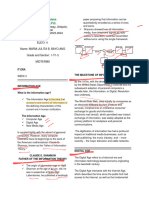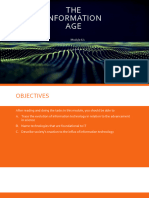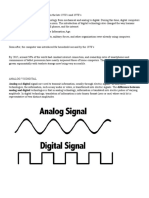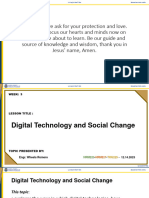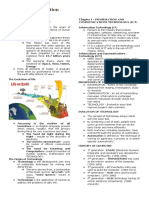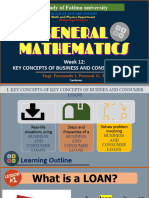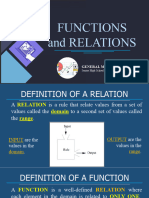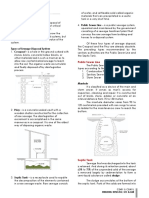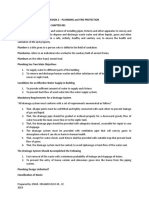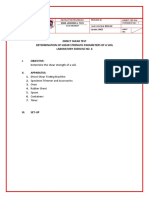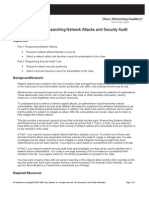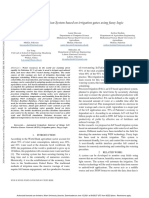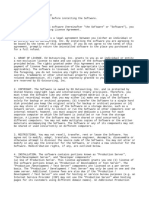Group 3
Goal Diggers
Agustin, Juan
Gamurot, Kristine
Lactao Blesie Joyce
Pitacio, Jessica
Samson, Ronnel
CURRENT TRENDS AND EMERGING TECHNOLOGIES
1. Artificial Intelligence (AI)
- computer systems built to mimic human intelligence.
- AI refers to the computers having the capabilities of performing tasks like a human.
- AI can do these tasks faster and more accurately than humans.
Benefits
Enhanced Automation
Eliminates the Necessity for Humans to Perform Tedious Tasks
Smart Weather Forecasting
Next Generation Disaster Response
Zero Scope for Errors
2. 5G data networks
- 2020 is likely to be the year when 5G really starts to fly
3. Internet of Things (IoT)
- a giant network of connected things and people all of which collect and share data about the
way they are used and about the environment around them.
- Iot made possible for devices like Alexa, Bixby and Google Home to function.
- It can enable predictive maintenance, speed up medical care, improve customer service, and
offer benefits we haven’t even imagined yet.
4. Blockchain
- is a shared, immutable ledger that facilitates the process of recording transactions and tracking
assets in a business network
- a system in which a record of transactions made in bitcoin or another cryptocurrency are
maintained across several computers that are linked in a peer-to-peer network.
5. Virtual Reality and Augmented Reality
- Virtual Reality (VR) immerses the user in an environment while Augment Reality (AR)
enhances their environment.
Benefits of AR and VR
Make The eLearning Process engaging and exciting
Create Scenarios That Otherwise Are Impossible To Create
Allow for Self-Guided Exploration
� 6. Computer Vision
- involves systems that can identify items, places, objects or people from visual images – those
collected by a camera or sensor.
DIGITAL TECHNOLOGY AND SOCIAL CHANGE
Schumpeter’s notion of socioeconomic evolution through technological change.
Creative Destruction
Introduction to Digital age
ICT and it’s role in Social Change
Global Digital Development
Technological Change
Social Evolution
Digital Technology
Stone, Bronze, Iron Age
Industrial Revolution
Transformation of Information
Social Change
Information and Communications Technology gives a chance for people from around the world to
communicate, leading to the success of various advocacies.
DIGITAL REVOLUTION
The Digital Revolution began between the late 1950’s and 1970’s.
It is the development of technology from mechanical and analog to digital. During this time, digital
computers and digital record keeping became the norm. The introduction of digital technology also changed
the way humans communicate, now via computers, cell phones, and the internet.
This revolution led way to the Information Age.
1950’s and 1960’s, many governments, military forces, and other organizations were already using
computers.
Soon after, the computer was introduced for household use and by the 1970’s
By 2015, around 50% of the world had constant internet connection, and ownership rates of smartphones
and commonness of tablet possession have nearly surpassed those of home computers. The ability to
store information has grown exponentially with terabyte storage now being very accessible.
ANALOG VS DIGITAL
Analog and digital signals are used to transmit information, usually through electric signals. In both these
technologies, the information, such as any audio or video, is transformed into electric signals. The
difference between analog and digital technologies is that in analog technology, information is translated
�into electric pulses of varying amplitude. In digital technology, translation of information is into binary format
(zero or one) where each bit is representative of two distinct amplitudes.
Digital Age
- Computer Age, Digital Age, or New Media Age
- a historic period in the 21st century characterized by the rapid shift from traditional industry that
the Industrial Revolution brought through industrialization, to an economy based on information technology.
- Time frame in history that the use of digital technology became prevalent and of common use
throughout the world. The digital age began in earnest with the widespread use of the Internet
- The period of the introduction of the personal computer with subsequent technology in providing
the ability to transfer information freely and quickly in human history characterized by the shift from
traditional industry
- captures the ubiquitous nature of computing and the prolific use of technology in almost all aspects
of human activity such that digital interaction is a defining characteristic of human activity.
- The age of widespread use of technological products and networks and technological methods’
over traditional methods in life practices.
- The generation in history during which the use of digital technology became ubiquitous throughout
the world.
Ten Commandments of Digital Age
1. TIME Do Not Be Always On
2. PLACE Live in Person
3. Choice
4. Complexity
5. Scale
6. Identity
7. Social
8. Fact
9. Openness
10. Purpose
ICT ROLE IN SOCIAL CHANGE
- Information and Communications Technology
- Refers to TECHNOLOGIES
- Shows how MODERN SOCIETY WORKS
- EASILY ACCESSED AND USED IN EVERYDAY LIVING
- Allows people to communicate easily which then LEADS TO VARIOUS ADVOCACIES
�SOCIAL CHANGE
- ALTERATION OF HUMAN INTERACTIONS and RELATIONSHIPS
- Transforms cultural and social institutions which has a profound and long-term consequences
TUNISIAN REVOLUTION
- DECEMBER 2010
- JASMINE REVOLUTION
- 28-day Civil Resistance Campaign
- High Employment, Food Inflation
- Ousting of long-time president Zine El Abidine Ben Ali
- LACK OF POLITICAL FREEDOM AND POOR LIVING CONDITION
- PLACED SOCIAL MEDIA TO SPREAD AWARENESS AROUND THE GLOBE
WOMEN’s LEARNING PARTNERSHIP
- ELIMINATE MARGINALIZATION OF WOMEN
- GENDER JUSTICE AND HUMAN RIGHTS ADVOCACY
- Advance way of communicating with women around the world in order to promote gender justice
and human rights, particularly in MUSLIMS
- TO EMPOWER WOMEN TO TRANSFORM THEIR FAMILIES, COMMUNITIES AND SOCIETIES
- PROTECT HUMAN RIGHTS, FACILITATE SUSTAINABLE DEVELOPMENT AND PROMOTE
PEACE
ROLE OF ICT
- Cyber-bullying, promotion for feminism, abolition of slavery or industrial revolution
- ICT GIVES AN OPPORTUNITY FOR PEOPLE TO BE AWARE OF THE PROBLEMS IN THE
SOCIETY
- OFFERS PEOPLE THE OPPORTUNITY TO PARTICIPATE AND BE PART OF THESE SOCIAL
CHANGES











